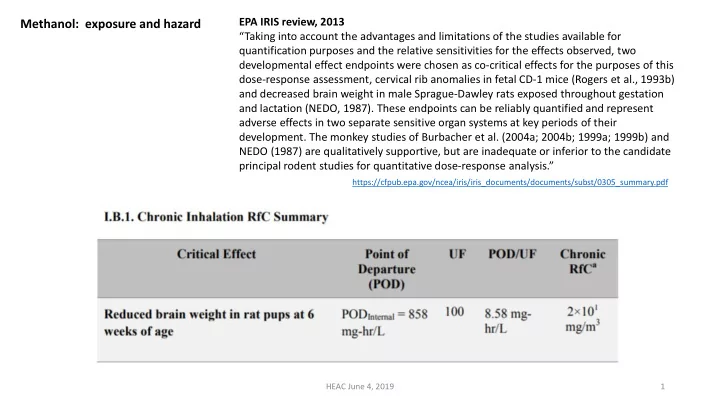

EPA IRIS review, 2013 Methanol: exposure and hazard “Taking into account the advantages and limitations of the studies available for quantification purposes and the relative sensitivities for the effects observed, two developmental effect endpoints were chosen as co-critical effects for the purposes of this dose-response assessment, cervical rib anomalies in fetal CD-1 mice (Rogers et al., 1993b) and decreased brain weight in male Sprague-Dawley rats exposed throughout gestation and lactation (NEDO, 1987). These endpoints can be reliably quantified and represent adverse effects in two separate sensitive organ systems at key periods of their development. The monkey studies of Burbacher et al. (2004a; 2004b; 1999a; 1999b) and NEDO (1987) are qualitatively supportive, but are inadequate or inferior to the candidate principal rodent studies for quantitative dose-response analysis.” https://cfpub.epa.gov/ncea/iris/iris_documents/documents/subst/0305_summary.pdf HEAC June 4, 2019 1
1- Bromopropane: new hazard – neurological effects - NIOSH, CDPH hazard alert on neurological effects of 1-BP: https://www.osha.gov/dts/hazardalerts/1bromopropane_hazard_alert.html - CalOSHA PEL (5 ppm) based on developmental/reproductive effects HEAC June 4, 2019 2
Diethylene Glycol monobutyl Ether: Usage - Approx 1400 California workplaces - Provisional RfC available = 0.0001 mg/m3 (USEPA , SuperFund Program) https://hhpprtv.ornl.gov/issue_papers/DiethyleneGlycolMonobutylEther.pdf Average Daily Amount SIC Total # of Users (gal) 11-19 66 618.3 20-29 226 857.6 30-39 284 344.1 40-49 160 640.0 50-59 389 243.1 60-69 22 5.0 70-79 104 83.8 80-89 81 33.5 90-99 44 407.1 Total 1376 HEAC June 4, 2019 3
Dicyclopentadiene - substantial change in the value of an OEL ACGIH, 2019: 0.5/1 ppm TWA/STEL to minimize potential for upper respiratory tract and eye irritation and central nervous effects. PEL: 5 ppm based HEAC June 4, 2019 4
Monochloroacetic acid: Usage, No PEL ACGIH (2005) = 0.5 ppm; OELs are available for comparison HEAC June 4, 2019 5
DEHP: seriousness of the hazard – reproductive and developmental effects - listed on ACGIH 2019 Notice of Intended Changes; 0.03 mg/m 3 proposed - PEL of 5 mg/m 3 based on irritation and possible neurotoxicity (ACGIH, 2001) HEAC June 4, 2019 6
PCBTF ( p-chloro-alpha,alpha,alpha-trifluorotoluene): Usage Tumors in rats and mice (NTP, 2018) IARC will review November 2019 - https://monographs.iarc.fr/wp-content/uploads/2018/12/Vol-125-Preliminary-List-of-Agents.pdf Top types of facilities storing chemical: Number of SIC Code Descriptor Facilities Null 140 Top, Body, and Upholstery Repair Shops and Paint Shops 79 #N/A 57 Paint, Glass, and Wallpaper Stores (glass) 50 Commercial Printing, Lithographic (quick printing) 31 Paints, Varnishes, and Supplies 27 Paints, Varnishes, Lacquers, Enamels and Allied Products 24 Lumber and Other Building Materials Dealers (except home centers) 15 Roofing, Siding, and Insulation Materials 12 General Automotive Repair Shops 10 Chemicals and Chemical Preparations, NEC (except frit and table salt) 8 General Warehousing and Storage (miniwarehouses and self-storage units) 7 Aircraft Parts and Auxiliary Equipment, NEC (research and development) 7 Signs and Advertising Specialties (signs) 6 Schools and Educational Services NEC (except instruction) 6 Wood Office Furniture 6 Chemicals and Allied Products, NEC 6 Motor Vehicle Supplies and New Parts (Wholesale) (auto parts sold via retail method) 6 Industrial Machinery and Equipment HEAC June 4, 2019 5 7
Carbon tetrachloride: Seriousness of hazard USEPA IRIS review 2010: - new RfC - new lower Inhalation Unit Risk HEAC June 4, 2019 8
Phthalic Anhydride – substantial change in OEL, seriousness of hazard ACGIH, 2014: 0.001/0.005 ppm; basis: respiratory sensitization, asthma PEL: 1 ppm HEAC June 4, 2019 9
Titanium Dioxide: substantial change in OEL, seriousness of hazard - Titanium Dioxide is on the ACGIH Under Study List NIOSH recommends 2.4 mg/m 3 for fine TiO2 and 0.3 mg/m 3 for ultrafine TiO 2 - PEL for TiO 2 : 10 total/5 respirable mg/m 3 - From NIOSH Current Intelligence Bulletin 63: “NIOSH recommends …. using the international definitions of respirable dust [CEN 1993; ISO 1995] and the NIOSH Method 0600 for sampling airborne respirable particles [NIOSH 1998].” https://www.cdc.gov/niosh/docs/2011-160/pdfs/2011-160.pdf HEAC June 4, 2019 10
Recommend
More recommend